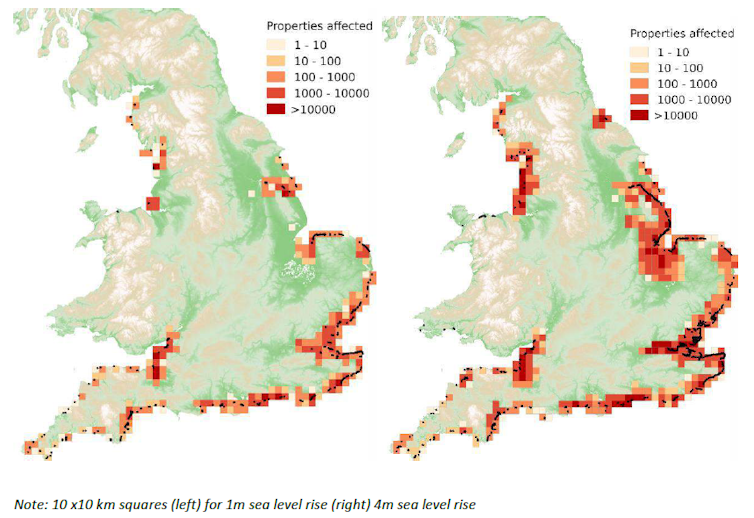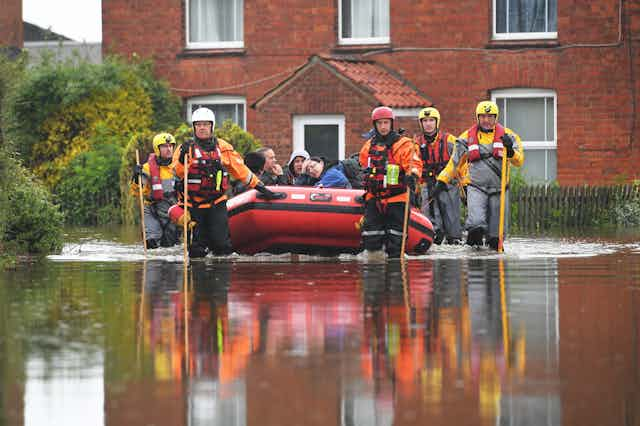As an island nation, Britain has vulnerable communities that must be prepared for the impact of the climate emergency. And while much has been said about homes at risk from the sea in coastal regions, or those inland subject to river flooding, the UK Committee on Climate Change’s new progress report for 2019 has laid bare the challenge facing them.
In 2018, Hemsby on the coast of Norfolk in the east of England saw several homes dramatically lost after storm surges caused metres of the sandy cliff edge to collapse. Over the last decade, major storms left substantial areas of England badly flooded for weeks or months, such as in 2007, 2009, 2012, and the winters of 2013-14 and 2015-16. The Environment Agency has said that the UK faces having to abandon areas rather than continue to defend them with the ever higher and stronger flood defences that would be necessary.
According to the committee’s climate change risk assessment it is almost certain that England will have to adapt to at least one metre of sea level rise. Modelling studies have shown that flooding increases exponentially with rising sea levels. So for coastal areas subject to flooding it is not sufficient to increase the height of sea walls in line with sea level rise.
The assessment predicts that up to 1.5m properties (including 1.2m residential homes) may be located in areas with an annual flood risk of once in 200 years or more by the 2080s. Around 8,900 properties are located in areas at risk from coastal erosion, this may increase to over 100,000 properties by the 2080s. While coastal erosion affects fewer properties than flooding, the impact is more drastic due to the inevitable and irrecoverable loss of land to the sea.
Significant increases in coastal flood risk are projected to occur as early as the 2020s due to increases in storm frequency. According to the committee’s projections the number of residential properties exposed to flooding more frequently than once every 75 years (on average) is predicted to increase 20% by the 2020s under the scenario which gives a 4°C rise in global temperatures by the 2080s.
However, the Committee on Climate Change’s latest report on dealing with these issues scores work on alleviating surface water flooding, and work on ensuring new building development is properly designed to manage flooding, both firmly in the “red” of the red-amber-green traffic light system indicating readiness. Other aspects of flood protection fare only slightly better, with river and coastal development flood protection and alleviation and flood recovery in general marked as “amber”.

In the Netherlands, for centuries vulnerable to floods due to its low-lying land, a number of new approaches to water management have been adopted over the years in an effort to live with water rather than to fight it. Schemes range from flood-proof homes, including floating homes, to the Room for the River programme which entails strategies for planned evacuations, temporary relocation of farmers and villagers, and strategic flooding of polders (reclaimed areas separated by drainage dykes).
The UK has its own approaches to manage increased flood risk, and is developing new approaches in view of the dire predictions by climate change experts under scenarios of both 2°C and 4°C global temperature rise. River flooding and coastal flooding (from waterway or coastal inundation), as well as surface water and groundwater flooding (from rain and storms and insufficient drainage), were categorised as the most significant sources of risk in the UK now and in the future.
Coastlines changed
The committee’s projection of flood risk has identified the most cost-effective, engineering-based measures to reduce flooding as improving defences, managed realignment of the coast, catchment area management, and urban runoff management through sustainable drainage systems. In this case, “realignment” of the coast entails not only the natural changes to the physical coastline as a result of climate change, but also the decision to abandon or relocate entire settlements. This can have a significant personal and financial impact on those residents affected.
While the abandonment of properties in places like Happisburgh and Hemsby in Norfolk due to coastal erosion is well known, we can see from the map above that many other coastal areas around the Humber, Mersey, Severn and Thames estuaries are at risk. Those affected, and also key infrastructure assets, will need to be evaluated to ascertain whether they should be included in this process of coastal realignment. The area around the Thames in southern England is likely to be classed as worth protecting due to the high numbers of people living there, for example. In addition, a number of low-lying inland plains will also be lost – many of which were selected for housing development only a few decades ago.
While planning and building regulations can reduce flood risk to new-build properties within affected areas, anticipated population growth means that there is increasing pressure to build on floodplains. According to Emma Howard Boyd, Chair of the Environment Agency, the number of properties built on floodplains will double over the next 50 years, creating further flood risk problems.
The UK has a significant number of key industries and infrastructure at the coast – for example power stations, petrochemical plants, steel industries and oil and gas infrastructure. To tackle the associated design challenges for housing, business and industries appropriate funding and having a well-skilled engineering force will be key.
In view of the increasing impact of climate change we need to urgently build our resilience to flooding. Flood resilience includes knowing what the risks are and where. We need flexible engineering solutions, including natural flood risk management, as well as ways to help society adapt. We need to make sure we have the right people with the right skills at all levels to address related socio-economic issues, including hard decisions on what to fight to keep, and what can be lost.

